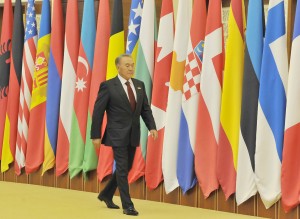 After much debate and lengthy negotiations, leaders from 56 Organisation for Security and Cooperation in Europe (OSCE) participating states, as well as numerous partners and international organisations, came to Astana on Dec. 1-2, 2010. Braving freezing weather and unfolding snowstorms, presidents and prime ministers from countries spanning from Vancouver across North America to Europe and all the way to Russia’s Vladivostok, came together to send one paramount message: The principles on which the original Conference for Security and Cooperation in Europe (CSCE) was founded in Helsinki in 1975 were just as relevant 35 years later. And what’s more, those principles were to be used in building a much wider community.
After much debate and lengthy negotiations, leaders from 56 Organisation for Security and Cooperation in Europe (OSCE) participating states, as well as numerous partners and international organisations, came to Astana on Dec. 1-2, 2010. Braving freezing weather and unfolding snowstorms, presidents and prime ministers from countries spanning from Vancouver across North America to Europe and all the way to Russia’s Vladivostok, came together to send one paramount message: The principles on which the original Conference for Security and Cooperation in Europe (CSCE) was founded in Helsinki in 1975 were just as relevant 35 years later. And what’s more, those principles were to be used in building a much wider community.
The summit was historic because it was the first OSCE summit in 11 years and because it took place in the former Soviet republic for the first time. It was also historic for the decision it took to approve the “Astana Commemorative Declaration: Towards a Security Community,” committing all states “to the vision of a free, democratic, common and indivisible Euro-Atlantic and Eurasian security community stretching from Vancouver to Vladivostok, rooted in agreed principles, shared commitments and common goals.”
In the declaration, the heads of state and government reiterated “commitment to the concept, initiated in the [Helsinki] Final Act, of comprehensive, co-operative, equal and indivisible security, which relates the maintenance of peace to the respect for human rights and fundamental freedoms, and links economic and environmental co-operation with peaceful inter-state relations.”
The declaration also established a vision of a security community, which should be aimed at meeting the challenges of the 21st century based on the full commitment to common norms, principles and obligations within the OSCE in all of its three famous dimensions of security – politico-military, economic and environmental, and human dimension. “These norms, principles and commitments have enabled us to make progress in putting old confrontations behind us and in moving us closer to democracy, peace and unity throughout the OSCE area. They must continue to guide us in the 21st century as we work together to make the ambitious vision of Helsinki and Paris a reality for all our peoples,” the leaders said in the declaration.
The summit capped Kazakhstan’s one-year chairmanship of the organisation, during which it faced some of the toughest security challenges in recent years, including a major upheaval in neighbouring Kyrgyzstan with a rather real threat of it escalating into a civil war. It was Kazakhstan’s handling of that crisis on behalf of the OSCE, in partnership with the United Nations and the European Union with the support of Russia and the United States, that became one of the defining moments of its chairmanship.
Kazakhstan also tried to equally focus on all three baskets of the OSCE’s priorities, for example, directing greater efforts to help stabilise Afghanistan and resolve so called protracted conflicts in South Caucasus and Transnistria, working to improve transportation management in the vast area and seeking to promote tolerance. Its motto was Trust, Traditions, Transparency and Tolerance.
Three years on, the legacy of the summit lives on as successive chairmanships by Lithuania, Ireland and Ukraine continue to work to implement the vision agreed upon in Astana and develop it further. The OSCE has grown more relevant and active in pursuing its responsibilities and it has also grown by one member to 57 states, accepting Mongolia as a fully participating state. As the backdrop for these actions, the Astana Declaration remains the most important and the only highest-level political document accepted within the OSCE over the past decade. It will clearly remain relevant for years to come.
The successive chairmanships have pursued such priorities as Helsinki Plus 40, an updated vision for the organisation; strengthening confidence building measures in the military area and improving arms control; helping Afghanistan; countering trans-national threats; tolerance and gender equality. Also of continuous priority are democracy and human rights, the rule of law and fundamental freedoms, as well as further efforts to promote economic, environmental and energy security. And the future of OSCE field presences and operations in Central Asia, South Caucasus and the Balkans remain in constant focus.
The upcoming council of foreign ministers in Kyiv on Dec. 5-6 is set to review all of these issues and adopt relevant decisions. The three years since the OSCE summit in Astana have shown that that event was timely and, as promised, indeed helped give a much needed boost to the organisation. Its continued success and relevance in the face of evolving challenges, though, will depend on the ability of all participating states to find compromises and on their desire to work together to reach the consensus needed to approve all of its decisions. Such a trend will certainly benefit all participating states, from the U.S. and Canada to European and Eurasian nations.

